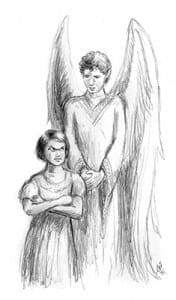The girl who didn’t trust angels
By LORRAINE V. MURRAY, Commentary | Published July 24, 2014
When one of the sisters in elementary school first told me I had a guardian angel, I was thrilled. In my mind’s eye I pictured a winged being in long flowing robes standing lovingly at my side.
It never once crossed my mind to envision the angel as an invisible tattletale who was keeping tabs on me. Nor did I ever consider giving my angel a good punch in the nose so it would leave me alone.
But these were the reactions of another little girl, one named Mary Flannery O’Connor, who went on to become a highly acclaimed Southern writer and recipient of the National Book Award for fiction.
About eight years ago I began writing a book about her life, which was largely based on her letters. Biographers never know what they will uncover, and as I dug deeper and deeper, a few things stood out loud and clear.
This was a brilliant woman, a fervent Catholic and a great soul. This was someone who suffered terribly from the effects of lupus, which took her life at age 39, but remained true to her vocation of writing. Someone who generously answered friends’ questions about everything from raising peacocks to regaining their faith in God.
But there was something else about her I simply couldn’t deny, and that was her unflagging sense of humor. This was a woman who took her driving test and reported, “I barely brought the patrolman back alive.” A woman who admitted some visitors left her feeling exhausted and “yearning to go sit with the chickens.”
Nowhere was her humor seen more vividly than in her account of her childhood relationship with her guardian angel.
She was eight when the sisters first told her about this special spiritual companion. Her honest reaction? “My dislike of him was poisonous,” she admitted in a letter written when she was 31.
It is possible the young Mary Flannery O’Connor pictured the angel stalking her around, recording her misdeeds and then reporting on her to God. And maybe this is why she developed a malady she claimed the Freudians had not yet named, which O’Connor drily called “anti-angel aggression.”
This aggression manifested itself now and again when the little girl would confront the angel in a locked room. There, “with a fierce (and evil) face” she whirled around in a circle with fists knotted, “socking the angel.” Her dislike was so intense, she said, that at times she kicked at him “and landed on the floor.”
Because the sister had told the children that angels have wings, little Mary Flannery concluded the creature was covered in feathers. And although the child knew she couldn’t actually hurt the angel, she would have been happy to know she had “dirtied his feathers.”
She went on to tell her friend that the Lord—“by His Merciful Kindness”—removed that fixation from her life, and that was the end of her plan to vanquish her guardian angel.
O’Connor didn’t give angels a great deal of thought until she was 29 and received a holy card in the mail with a prayer to St. Raphael on it. She was delighted to discover he was an archangel, and tuned in immediately to the prayer, which asks him to guide us to “our true country” and “the province of joy.”
After doing some research on angels, she was comforted to find out, as she put it, “what they were not.” She didn’t elaborate in her letter, but she apparently abandoned her notion that these spiritual beings were feathery spies.
Ten years later—a few months before she died—she confided to another friend that she was still saying the same daily prayer to St. Raphael. And the holy card remained with her right until the end when it was found on her bedside table in the hospital.
August 3 marks the 50th anniversary of her death—and I pray that St. Raphael did indeed answer her request. I hope O’Connor has found peace and joy in her true country, which is heaven. I also hope she had a chance to meet her guardian angel face-to-face and perhaps mend a few fences.
Lorraine is the author of “The Abbess of Andalusia: Flannery O’Connor’s Spiritual Journey,” which covers O’Connor’s favorite saints, her daily prayers, her trip to Lourdes and her love for the birds and beasts of Andalusia. Artwork is by Jef Murray. Readers may reach the Murrays at lorrainevmurray@yahoo.com.